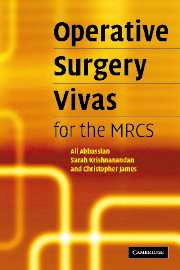Book contents
- Frontmatter
- Contents
- Preface
- 1 The elective repair of an abdominal aortic aneurysm
- 2 Adrenalectomy
- 3 Amputation (below knee)
- 4 Anorectal abscesses, fistulae and pilonidal sinus
- 5 Appendicectomy
- 6 Principles of bowel anastomosis
- 7 Breast surgery
- 8 Carotid endarterectomy
- 9 Carpal tunnel decompression
- 10 Central venous cannulation
- 11 Cholecystectomy (laparoscopic)
- 12 Circumcision
- 13 Colles' fracture (closed reduction of)
- 14 Compound fractures
- 15 Dupuytren's contracture release
- 16 Dynamic hip screw
- 17 Fasciotomy for compartment syndrome
- 18 Femoral embolectomy
- 19 Femoral hernia repair
- 20 Haemorrhoidectomy
- 21 Hip surgery
- 22 Hydrocele repair
- 23 The open repair of an inguinal hernia
- 24 Laparotomy and abdominal incisions
- 25 Oesophago-gastroduodenoscopy
- 26 Orchidectomy
- 27 Parotidectomy
- 28 Perforated peptic ulcer
- 29 Pyloric stenosis and Ramstedt's pyloromyotomy
- 30 Right hemicolectomy
- 31 Skin cover (the reconstructive ladder)
- 32 Spinal procedures
- 33 Splenectomy
- 34 Stomas
- 35 Submandibular gland excision
- 36 Tendon repairs
- 37 Thoracostomy (insertion of a chest drain)
- 38 Thoracotomy
- 39 Thyroidectomy
- 40 Tracheostomy
- 41 Urinary retention and related surgical procedures
- 42 Varicose vein surgery
- 43 Vasectomy
- 44 Zadik's procedure
36 - Tendon repairs
Published online by Cambridge University Press: 16 October 2009
- Frontmatter
- Contents
- Preface
- 1 The elective repair of an abdominal aortic aneurysm
- 2 Adrenalectomy
- 3 Amputation (below knee)
- 4 Anorectal abscesses, fistulae and pilonidal sinus
- 5 Appendicectomy
- 6 Principles of bowel anastomosis
- 7 Breast surgery
- 8 Carotid endarterectomy
- 9 Carpal tunnel decompression
- 10 Central venous cannulation
- 11 Cholecystectomy (laparoscopic)
- 12 Circumcision
- 13 Colles' fracture (closed reduction of)
- 14 Compound fractures
- 15 Dupuytren's contracture release
- 16 Dynamic hip screw
- 17 Fasciotomy for compartment syndrome
- 18 Femoral embolectomy
- 19 Femoral hernia repair
- 20 Haemorrhoidectomy
- 21 Hip surgery
- 22 Hydrocele repair
- 23 The open repair of an inguinal hernia
- 24 Laparotomy and abdominal incisions
- 25 Oesophago-gastroduodenoscopy
- 26 Orchidectomy
- 27 Parotidectomy
- 28 Perforated peptic ulcer
- 29 Pyloric stenosis and Ramstedt's pyloromyotomy
- 30 Right hemicolectomy
- 31 Skin cover (the reconstructive ladder)
- 32 Spinal procedures
- 33 Splenectomy
- 34 Stomas
- 35 Submandibular gland excision
- 36 Tendon repairs
- 37 Thoracostomy (insertion of a chest drain)
- 38 Thoracotomy
- 39 Thyroidectomy
- 40 Tracheostomy
- 41 Urinary retention and related surgical procedures
- 42 Varicose vein surgery
- 43 Vasectomy
- 44 Zadik's procedure
Summary
Why are repair of flexor tendons in the hand challenging?
This is because they are contained in well-lubricated synovial sheaths therefore:
After lacerations they can readily retract a longer distance proximally.
The repair must allow free gliding of the tendon within its sheath to ensure a normal function.
Damage to the sheath and the various pulleys can result in bow stringing of the affected tendons reducing grip strength.
Unsatisfactory post-repair rehabilitation may result in adhesions within the sheath resulting in inadequate function.
Describe the different zones of flexor tendon injuries in the hand
Zone I Distal to the insertion of flexor digitorum superficialis (FDS) thus only contains the flexor digitorum profundus (FDP) tendon in the flexor sheath.
Zone II This zone is from the beginning of the flexor sheath in the distal palm proximally to the start of Zone I distally. Zone II contains both the FDP and FDS tendons in the flexor sheath.
Zone III This zone starts distal to the carpal tunnel and end at the beginning of Zone II thus containing all the tendons free from synovial sheath in the palm.
Zone IV This is the carpal tunnel with the tendons lying under the flexor retinaculum.
Zone V This refers to the tendons proximal to the carpal tunnel in the forearm.
Describe a technique for repair of a tendon
A core suture (Kessler repair) is used, ensuring that the knot is within the tendon as illustrated. This will reduce the bulk of the repair and allow easier gliding of the tendon. This is augmented by smaller circumferential sutures.
- Type
- Chapter
- Information
- Operative Surgery Vivas for the MRCS , pp. 135 - 136Publisher: Cambridge University PressPrint publication year: 2006



